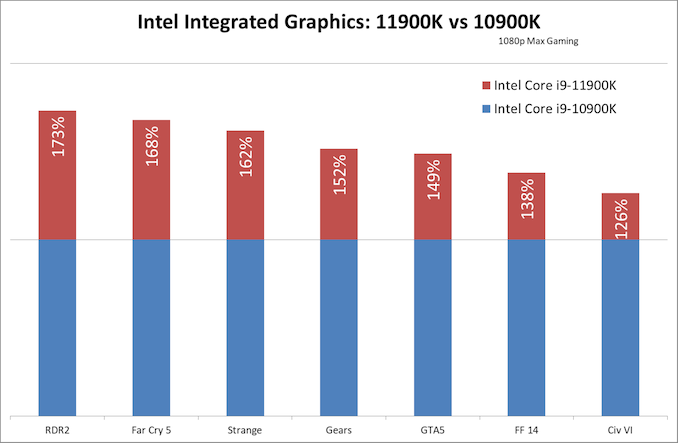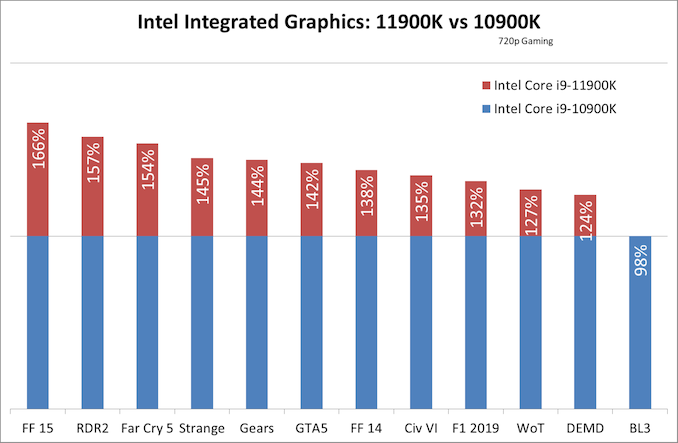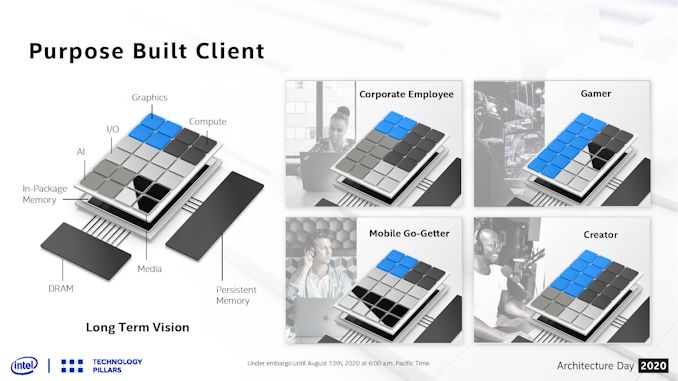Intel’s Integrated Graphics Mini-Review: Is Rocket Lake Core 11th Gen Competitive?
by Dr. Ian Cutress on May 7, 2021 10:20 AM ESTConclusions
No-one ever said that integrated graphics solutions had to be good. Nonetheless there is always the desire for something better, something higher performance, and something suitable for end-users. At the beginning of the era of integrated graphics, the focus was on simply providing something basic for 2D work - applications on an operating system and no real graphics rendering to mention. That solution is simple enough, however the demand on integrated graphics has grown over time, especially as the demands we put on our devices have also grown.
A modern system, especially a commercial system or one designed for work, has to do it all. Anyone not working in graphics might depend on a integrated solution to navigate complex arty web interfaces for the tool they use, or rely upon the acceleration features now baked into those platforms. Also perhaps, from time to time, some mild gaming use as well, if not outright using the compute features of the graphics for transcoding or AI. These demands are most heavily focused on mobile platforms, and as a result mobile platforms from Intel tend to get the best integrated graphics solutions, especially in thin-and-light designs where a discrete graphics solution is too power hungry. Intel's mobile Tiger Lake-U series offers a sizeable 96 execution units of the latest generation graphics architecture, compared to the desktop processors we are testing today, that only have 32.
So what use is a desktop processor with integrated graphics?
AMD and Intel both have product lines with integrated graphics. From Intel, its integrated graphics is in almost everything that Intel sells for consumers. AMD used to be that way in the mid-2010s, until it launched Ryzen, and now we have separate CPU-only and CPU+Graphics options. This is where the company philosophy differs.
AMD's desktop processors with integrated graphics are primarily intended to be a whole system replacement, with users relying on the integrated graphics for all their graphics needs. As a result AMD puts a lot more processing hardware into its integrated graphics solutions for the desktop, and it results in a good gaming experience for entry level gaming.
Intel's route on the otherhand is a bit more basic. The desktop integrated graphics here has two main directions: first, as the basic graphics needed for an office system, or second, more of a fall-back option for when the discrete card doesn't work or fails in more premium desktop systems. The power isn't there for hardcore grunt like gaming of any serious note, but it is certainly enough to cover the basics.
Despite this, with the new Xe-LP graphics solution, Intel has some aces up its sleeve. First is AV1 decoding, which allows users to watch AV1 content without putting stress on the CPU. Second is video encoding accelerationt through QuickSync, which has actually been a part of Intel's graphics for a number of years. Third is a relatively new feature: Intel's 'additional processor' mentality. Normally when a system has a discrete graphics card, the integrated graphics is disabled. But now, with its latest mobile devices for example, when Intel pairs its mobile processor with integrated graphics with a second graphics solution at about the same performance, with the right software Intel allows both graphics to work asynchrouusly on two different problems. The limit to this in the past has been dictating which graphics is the video out rather than simply a compute accelerator, but Intel believes it has worked it out. However, this is relatively little use for gaming, the topic of today.
Results Summary
In this review, we highlighted that Intel has now implemented its new Xe-LP graphics architecture onto its desktop processor line, and tested the new solutions against our traditional CPU gaming test suite. What we saw, in terms of a generational uplift from the i9-10900K to the i9-11900K, is actually quite impressive:
In our 720p testing, there's a clear generational gain across the board for Rocket Lake, and in most cases the games become a lot more playable. The average gain is 39%. If we flip to our gaming results at the higher resolution and settings:

Games with under 10 FPS across the board are left out
For these titles, the average gain is 153%, showing that Xe-LP is certainly a step up regardless of the workload.
The Future of Integrated Graphics
A key talking point about integrated graphics is whether a company should leverage a strong CPU product at the expense of graphics, or aim for something with strong integrated graphics as a more complete chip at the expense of the mid-range graphics market. The console market for example relies fully on integrated graphics designs, especially as it keeps the manufacturing simpler and number of chips lower. But on the desktop space, because discrete graphics are an option (well, when we're not in a mining craze or semiconductor shortage), there seems to be no impetus for companies to do a full fat integrated graphics solution that competes on the same stage as a mid-range graphics card. AMD could do it, but it might overlap with their console agreements, and Intel hasn't done anything serious since Broadwell.
To put a nod to Broadwell, Intel's 5th Gen processor. It was so powerful at integrated graphics at the time, we are still using it today as a comparison point when comparing against other Intel solutions. Broadwell had dedicated 48% of the die area of its top processor to graphics, and for that product it also added some really fast cache memory as well. Intel's focus on integrated graphics as a function of die size has decreased over time, now with Rocket Lake sits at around 20% of the silicon. It hasn't been this low since Intel first introduced its integrated graphics solutions. For that 20%, we get 32 execution units with eight processing cores. Tiger Lake has 96 EUs which total around 33% of overall die size, but has four cores. If Intel was focused on graphics performance in the same way as it was in Broadwell, we might be looking at a 256+ EU solution.
With Intel taking a renewed approach to graphics with its Xe portfolio, stemming from entry up to high performance compute, there is room here for Intel to develop integrated graphics focused solutions. Intel has detailed that it is moving to chiplets with its future mainstream processors under its 'Client 2.0' strategy, and part of that is allowing customers to select how many IP blocks they want of cores, IO, memory, security, and graphics. In the image above, the Gamer option has half of the die area for graphics. This could at the end of the day be a target that could see Intel making desktop integrated graphics a focus again.












165 Comments
View All Comments
mode_13h - Friday, May 7, 2021 - link
> Need power efficiency? You want Tiger Lake, not Rocket Lake.Rocket Lake is 14 nm. They don't have enough 10+ nm fab capacity to sell desktop Tiger Lakes, but you can find them in SFF PCs and there are rumored to be NUCs with them, also.
Someone wanting more compute power should still prefer Rocket Lake, due to its higher core-count. We'll have to see what availability of the 8-core Tiger Lakes looks like, but I'm expecting it to be scarce & expensive.
> Cheap gaming? Corporate desktop? Bundle the CPU with DG1.
If someone needs more graphics horsepower, I'm sure that sometimes happens. It's not going to be cheaper than having an iGPU, however. So, if you're suggesting Intel should've left out the iGPU from Rocket Lake, that's going to be a deal-breaker for some customers.
> Bottom barrel systems? Nothing wrong with Comet Lake.
And you can still buy them. However, Rocket Lake offers more PCIe lanes and PCIe Gen 4. Its Xe GPU offers hardware-accelerated AV1 decode. There are some other benefits of Rocket Lake, but I agree that someone on a budget should probably be looking at Comet Lake.
MikeMurphy - Friday, May 7, 2021 - link
That's rather impressive performance from the 1185g7. Should we be factoring in the power envelope afforded to the mobile chips when comparing performance?Alistair - Friday, May 7, 2021 - link
that's not impressive, Apple's M1 is impressive, one of the reasons Apple abandoned Intel is their terrible IGP.GeoffreyA - Saturday, May 8, 2021 - link
Well, you know what they say about rats ;)Spunjji - Monday, May 10, 2021 - link
They're all impressive in different ways.M1 shows what you get if you go all-in on providing a large GPU on a cutting-edge process.
Vega 8 is impressive for the performance it provides in a relatively tiny area of the chip.
Xe is impressive for being so much better than Intel's previous efforts, and for currently being the best-performing iGPU on an x86 platform.
Alistair - Friday, May 7, 2021 - link
So AMD is ahead with the 4750G and 5700G, and Apple's M1 is WAY ahead. More crap from Intel.pman6 - Friday, May 7, 2021 - link
this is terrible.IGP is so important now that graphics cards are so damn expensive.
Looks like Alder Lake won't change much.
How long do I have to wait for the next AMD APU that has AV1 decode?
GeoffreyA - Saturday, May 8, 2021 - link
At most, till RDNA2 finds its way into the APUs, but possibly before that, because the video block is separate from the GPU.dsplover - Friday, May 7, 2021 - link
They’re so slow to respond to AMD. Maybe next year when they innovate something instead of more 14 nm cores.supdawgwtfd - Friday, May 7, 2021 - link
"so Intel has rebalanced the math engine while also making in larger per unit. "Say what now???